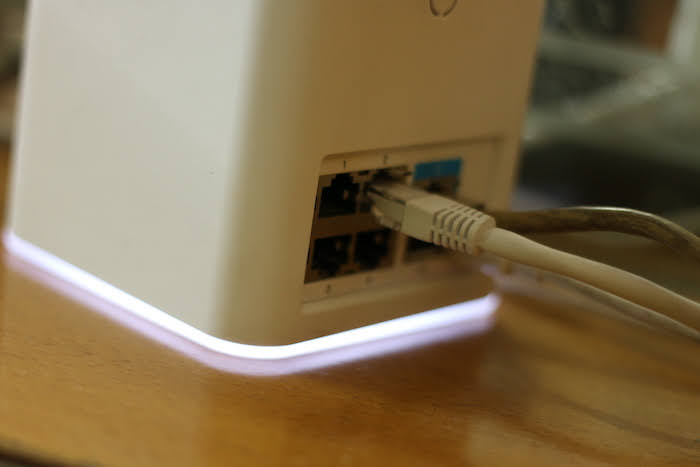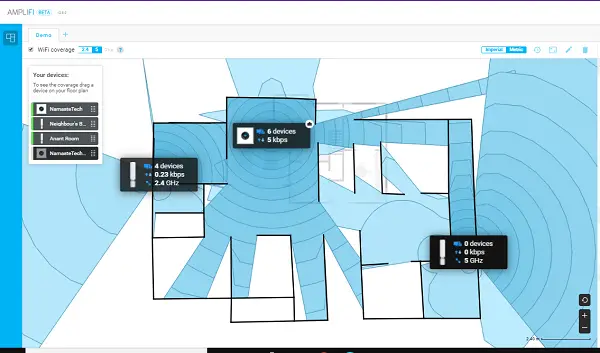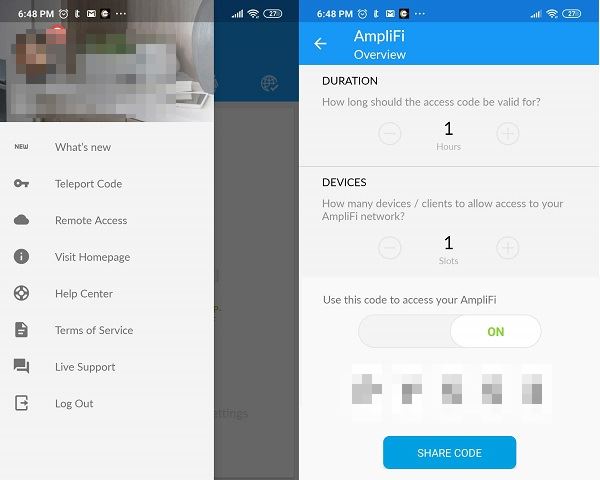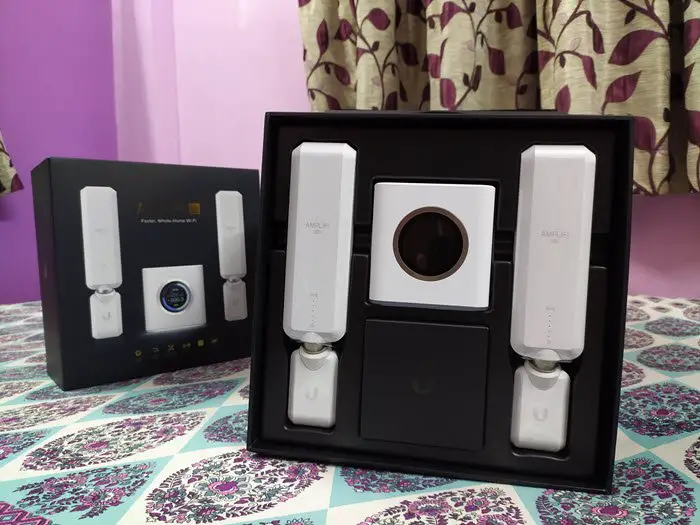Are you looking for a router capable of removing all weak points from your home? A router that looks beautiful and can extend out of your house while you have fun in your garden? It seems like you have to watch the AmpliFi HD Router. While on paper it can cover 10,000 square feet, we tested it for a 3,000 square foot house, and then we walked about 60 feet away, and it still worked. If you’re interested, keep reading our review of the beautiful AmpliFi HD router.
AmpliFi HD Router with WiFi Mesh Review
Ask anyone to define a router, and they would talk about the sharp things that come out of a flat-looking box. AmpliFi HD took me by surprise because it looked like a digital cube showing the time. I could imagine anything, but not a router. It is a 3.9 inch cube that is flat on all sides. It comes with a 1.6 inch screen and Ethernet ports, a rear USB port and a power outlet. Like AmpliFi Instant, it is an Ubiquiti mesh router without additional tentacles.
Since it is a mesh router, it comes with two wireless extensions that match the appearance of the router. These extensions are 7.1 inches long and are divided into two parts. The bottom is the AC adapter, while the top is the Wi-Fi unit, which can be configured for the specific band if required. These two connect via a magnetic ball and socket design, allowing you to adjust the antenna for better range. You can understand this by looking at the LED lights on it. If all the lights are on, then it’s connected.
main Features
- Tap the screen to rotate the clock, speedometer, IP address, port status, etc.
- The white LED at the bottom makes it fantastic.
- The mesh points connect automatically to the main router, which facilitates configuration.
- Band management and router management
- Optimizing devices for games and streaming
- Built-in firewall, which can only be changed when using it in Bridge mode
- On paper, it can cover 20,000 square feet and the range test seems legitimate. Main router has a range of 10,000 square feet
How to configure the AmpliFi instant router

Everything you want to configure is possible via their mobile application. You do not need to connect to a computer to configure it. At first I thought I would miss access to the office, but I don’t miss it at all. The mobile application is well designed and manages everything.
Launch the application, select the type of product you want to add, turn on the routers and configure it. If you do not have a modem configured, it supports DHCP, Static and PPPoE.
- You will have to create an account during its first configuration.
- Connect the Ethernet cable of your ISP to the blue Ethernet port or to the WAN port
- Then turn on the modem followed by the mesh router
- The application searches for the new router and, once found, press it and follow the configuration wizard to complete the configuration.
Once the basic configuration is complete, the application offers a dashboard where you can see the main router and the connected mesh points. At the bottom, you can see the number of connected clients, the download and upload speed. Tap the main router and it will reveal all the configuration details.
- General: Device name, time zone, location option, change password, reboot and factory reset
- Wireless: Security configuration, guest account, creation of additional SSIDs, configuration of the guide strip, router direction
- The Internet: If you need to configure DHCP, Static and PPPoE.
- LED and LCD brightness controEarth Night mode
- Apart from that, you can also configure UPnP, clone MAC address, VLAN ID, IPv6, port forwarding and bridge mode.

Here’s one thing to remember when setting up the SSID. If you have devices that require a 2.4 GHz band, you can create an additional SSID and choose to automatically broadcast on the 2.4 GHz and 5 GHz bands. Although the SSID of the main router broadcasts on both, the devices I had not connected. You must therefore create an additional SSID and select the band (2.4 GHz, 5 GHz or both) to broadcast. You can create an additional SSID on the main router or one of the mesh points.
 Note: There is no option to choose bands on the first SSID created on the main router. You can only set it for an additional SSID. So, if it sounds redundant, you can choose to hide the first SSID.
Note: There is no option to choose bands on the first SSID created on the main router. You can only set it for an additional SSID. So, if it sounds redundant, you can choose to hide the first SSID.
AmpliFi HD router performance and coverage

Once you’ve set up the router, you can go through a test to check the router and repeater coverage. You would need a plan or design on their website. The image below represents my house and that of my neighbor, which covers approximately 3000 m². Ft. In this tool, you can define the thickness of the walls, choose materials, etc. I wanted this simulation to be available to test before buying the router. Since it allows you to download the house blueprint, it can help you decide.
AmpliFi HD router performance
I have measured download speed and ping time at different distances. The router offers both 2, 0.4 GHz and 5 GHz, one of the repeaters was set to 2.4 GHz while the other was 5 GHz. The speed test and ping time were measured inside and outside my home. I had used the quick speed test app and the Fing tool.
The mine and neighbors house is on the first floor. I had placed a repeater on the neighbor’s balcony while the main router was placed in the center of our living room. The second router was set up at 2.4 GHz because I have some devices that needed it. It was 15 feet away with a wall in between.
Main router (5 GHz + 2.5 GHz) / (MPBS | Seconds)
- 2 hoursnd Floor (2 walls) 6.9 | Ping 28
- In the living room (about 10 ft)
Neighbor Balcony (5 GHz)
- At 60 feet: 11 | Ping 4
- At 45 feet: 13 | Ping 4
- At 20 feet with a wall: 5.1 | Ping 14
- At 10 ft (height 10 ft): 7.6 | Ping 6
- Inside the house
- At 30 feet: 16 | Ping 5
- At 60 feet: 4.5 | Ping 4
Corner chamber side (2.4 GHz)
- At 60 feet: 17 | Ping 6
- At 45 feet: 15 with a wall | Ping 6
- At 10 ft (10 ft high) | Ping 4
- Inside the house
It is clear from the ranges I tested that this device could go beyond 3000 square feet.
My favorite features of AmpliFi HD
Display
I love having a screen on the router. One of the best parts is that I can see an overview of essential things with a touch. It includes speed, router IP address, bandwidth consumption, and the number of connected devices. You can also activate WPA access by long pressing to quickly add a device. You can choose to stay on one of these modes if you wish.
Band management and router management
If you need to make sure the device connects to the main router, even if the mesh points are closer, you can use the router control method. It will offer better speed but at the cost of range. You can notice how the Internet speed decreases as the distance increases.
There are two bands on this 5 GHz and 2.4 GHz router. While the former offers better speed than later, the 2.4 GHz is useful for increasing the range. Band control ensures that the devices connect at 5 GHz, but if the signal weakens, it will go to 2.4 GHz.
Guest mode
The application facilitates quick management of Guest mode. While you can turn guest mode on and off with a single touch, make sure to secure it with a password. You can also choose multiple guests who can connect, share them via email or through messaging services.
QoS
QoS or “Quality of Service” is a feature that allows the router to prioritize speed and bandwidth depending on the type of consumption. AmpliFi does it in style. Each device can be configured into three categories: games, streaming and normal. The game gets the highest priority, followed by streaming and then normal.
I have a Smart TVC at home and I can optimize it for streaming, while PCs can have game priority. The best part, you can always switch modes from the app to improve overall performance. This feature is not available in
That said, it is only available for wireless clients. If you are using Ethernet, you will always have higher priority than wireless clients.
Profiles

It allows you to control the Internet for a group of devices. If you want to manage Internet access to a set of devices, you can add them to a group and benefit from silence time for these devices. You can add several “silent” times. You can also control access to individual devices by pressing the pause button next to it.
Teleportation and VPN
Ubiquity offers a free VPN as well as a teleportation feature to connect to services or devices that are back home. You can also use it to allow your friends and family to use your network. I explained in detail how to use it in the AmpliFi instant router.

Enough Ethernet ports
It houses four Ethernet ports, which is comparable to routers available on the market. If you’ve laid network cables all over your house, these will be helpful.
USB port
Although not yet functional, once enabled, it should be useful to connect to a printer or network storage device or a simple hard drive. From now on, you can use it to charge your phone or switch on another device.
Disadvantages of AmpliFi HD
- It can be difficult to find a location for the mesh points, especially if you want to have the best coverage. You will need two dedicated connection points that will not only be busy all the time, but should also be in the corners for better coverage. Otherwise, you can always run extensions.
- Mesh points are simple Wi-Fi units. So they just extend the Wi-Fi range. If you have devices that need Ethernet connections, you will need to connect to the router’s Ethernet via cables. So keep that in mind. If you have too many devices requiring an Ethernet connection, make sure you can get wires from the router to the devices.
- There is no way to know the bandwidth consumption of each device.
- There is no web interface to configure everything, but you can still type http: //amplifi.lan/ and define a few things. Honestly, the mobile app is reliable and you don’t miss the interface.
Awards and verdict
The router alone is priced at 137.45 USD or 15,459 INR. If you are looking for a powerful router for the home, but not the range, this alone should suffice. However, if you need more coverage, it’s best to advance the extensions. You can order it from Amazon following this link.

